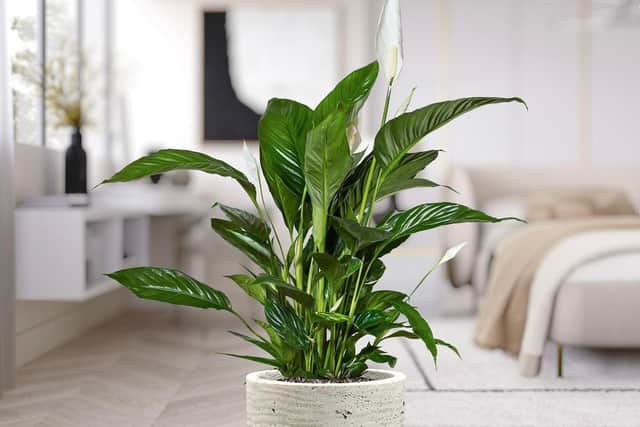How can you tell what’s wrong with four of these popular houseplants? Expert advises how to diagnose your houseplant
Hammonds Furniture has analysed the ways Brits should care for their houseplants and how to notice when there is something wrong with them.
In 2021, searches for ‘biophilic design’ houseplants shot up by 21 per cent and gardening enthusiasts have been sharing their houseplants on social media, with more than 8.2 million Instagram posts and 4.2 billion views on TikTok.
Chinese money plant


Advertisement
Hide AdAdvertisement
Hide AdThe Chinese money plant gets its name from the superstitions it inspired. Originating from Southwest China, some people believed that the plant would bring good luck and fortune to its owner.
The plant thrives in bright but indirect sunlight and if it is not getting enough light, it can make it grow tall and leggy. However, if you give them too much heat or light, their circular leaves can begin to curl inwards to form a cup shape. Dry, crispy spots can also mean your plant is getting too much direct sunlight.
If the stems of the plant are drooping, it may not be getting enough water, however, drooping stems and if the leaves turn a shade of yellow can mean that you have overwatered your plant and you need to give it a break.
Aloe vera
As is common knowledge, aloe vera’s leaves is often used as a remedy for minor burns and rashes or as a skin treatment.
Advertisement
Hide AdAdvertisement
Hide AdThey make great plants to liven up your bedroom decor because they harvest carbon dioxide at night, which improves your room’s air quality while you sleep. However, they are toxic to pets, so it’s best to keep them out of reach and sight of your animals.
An aloe vera plant can thrive on a bright and sunny windowsill, unlike the other plants listed here.
They are particularly suited to busy plant owners, as they store water in their leaves, so require very little watering and maintenance.
If your plant has dry tips, your plant is dehydrated and needs to be watered. However, for an aloe vera, less is more as this plant can be quite sensitive to overwatering, with leaves turning pale and yellow or in some cases brown. If your aloe’s leaves are looking brown and are mushy or soft at the touch, then you have overwatered your plant.
Monstera deliciosa, also known as Swiss cheese plant
Advertisement
Hide AdAdvertisement
Hide AdIts unique leaves and large size make this plant perfect for adding pizazz and interest to empty corners of the home.
Monstera plants can tolerate low light but grow faster if placed in indirect but bright sunlight. A monstera can exist happily in most area of the home, but they can get sunburnt if they receive too much direct sunlight.
Yellowing leaves or soft dark brown spots are a sign that you are overwatering your monstera and it needs to be dried out. If the leaves are brown and crispy on the edges, your plant is dehydrated.
Peace lily
With humidity and temperature, the peace lily needs a more particular arrangement; they should be kept away from cold draughts and will thrive best in a humid room, for example a bathroom. However, you can place your peace lily on display elsewhere in your home and mist the plant every few days to imitate the humid environment.
Advertisement
Hide AdAdvertisement
Hide AdThe plant should be watered every week but also make sure to check that the soil is dry before you water it. If your peace lily is wilting, you most likely need to water the plant as this is a sign of dehydration. But if the plant is drooping and the leaves are yellow, don’t water it as your plant has been overwatered already and needs a break.
Any dry flowers or scorched leaves means that your plant is suffering from having too much sunlight and needs to be moved elsewhere to a shadier spot in the house.
Gardening and plant expert at My Job Quote, Samantha Jones, said: “Bringing plants into your home can be beneficial to freshen up the atmosphere. Aside from being visually appealing and improving the aesthetics of your home, plants have a calming effect on us.
“Overall, the care of your plant is essential, so it is vital to make sure you give it the correct care. Each plant will have different needs, but there are some essential tips to follow if you’re just starting your houseplant journey.”
Ms Jones’ tips are:
Advertisement
Hide AdAdvertisement
Hide Ad- Keep your potting soil moist; the soil must be neither too wet nor too dry.
- Make sure that the plant pot has drainage holes in the bottom so your plant is never sat in water.
- Place your plant near a light source, whether natural or artificial.
- Lastly, if you are new to gardening, you should try to stick to low-maintenance plants such as aloe or monstera.
Comment Guidelines
National World encourages reader discussion on our stories. User feedback, insights and back-and-forth exchanges add a rich layer of context to reporting. Please review our Community Guidelines before commenting.